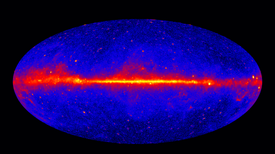


Gamma-ray astronomy is a subfield of astronomy where scientists observe and study celestial objects and phenomena in outer space which emit cosmic electromagnetic radiation in the form of gamma rays,[nb 1] i.e. photons with the highest energies (above 100 keV) at the very shortest wavelengths. Radiation below 100 keV is classified as X-rays and is the subject of X-ray astronomy.
In most cases, gamma rays from solar flares and Earth's atmosphere fall in the MeV range, but it's now known that solar flares can also produce gamma rays in the GeV range, contrary to previous beliefs. Much of the detected gamma radiation stems from collisions between hydrogen gas and cosmic rays within our galaxy. These gamma rays, originating from diverse mechanisms such as electron-positron annihilation, the inverse Compton effect and in some cases gamma decay,[2] occur in regions of extreme temperature, density, and magnetic fields, reflecting violent astrophysical processes like the decay of neutral pions. They provide insights into extreme events like supernovae, hypernovae, and the behavior of matter in environments such as pulsars and blazars. A huge number of gamma ray emitting high-energy systems like black holes, stellar coronas, neutron stars, white dwarf stars, remnants of supernova, clusters of galaxies, including the Crab Nebula and the Vela pulsar (the most powerful source so far), have been identified, alongside an overall diffuse gamma-ray background along the plane of the Milky Way galaxy. Cosmic radiation with the highest energy triggers electron-photon cascades in the atmosphere, while lower-energy gamma rays are only detectable above it. Gamma-ray bursts, like GRB 190114C, are transient phenomena challenging our understanding of high-energy astrophysical processes, ranging from microseconds to several hundred seconds.
Gamma rays are difficult to detect due to their high energy and their blocking by the Earth’s atmosphere, necessitating balloon-borne detectors and artificial satellites in space. Early experiments in the 1950s and 1960s used balloons to carry instruments to access altitudes where the atmospheric absorption of gamma rays is low, followed by the launch of the first gamma-ray satellites: SAS 2 (1972) and COS-B (1975). These were defense satellites originally designed to detect gamma rays from secret nuclear testing, but they luckily discovered puzzling gamma-ray bursts coming from deep space. In the 1970s, satellite observatories found several gamma-ray sources, among which a very strong source called Geminga was later identified as a pulsar in proximity. The Compton Gamma Ray Observatory (launched in 1991) revealed numerous gamma-ray sources in space. Today, both ground-based observatories like the VERITAS array and space-based telescopes like the Fermi Gamma-ray Space Telescope (launched in 2008) contribute significantly to gamma-ray astronomy. This interdisciplinary field involves collaboration among physicists, astrophysicists, and engineers in projects like the High Energy Stereoscopic System (H.E.S.S.), which explores extreme astrophysical environments like the vicinity of black holes in active galactic nuclei.
Studying gamma rays provides valuable insights into extreme astrophysical environments, as observed by the H.E.S.S. Observatory. Ongoing research aims to expand our understanding of gamma-ray sources, such as blazars, and their implications for cosmology. As GeV gamma rays are important in the study of extra-solar, and especially extragalactic, astronomy, new observations may complicate some prior models and findings.[3][4]
Future developments in gamma-ray astronomy will integrate data from gravitational wave and neutrino observatories (Multi-messenger astronomy), enriching our understanding of cosmic events like neutron star mergers. Technological advancements, including advanced mirror designs, better camera technologies, improved trigger systems, faster readout electronics, high-performance photon detectors like Silicon photomultipliers (SiPMs), alongside innovative data processing algorithms like time-tagging techniques and event reconstruction methods, will enhance spatial and temporal resolution. Machine learning algorithms and big data analytics will facilitate the extraction of meaningful insights from vast datasets, leading to discoveries of new gamma-ray sources, identification of specific gamma-ray signatures, and improved modeling of gamma-ray emission mechanisms. Future missions may include space telescopes and lunar gamma-ray observatories (taking advantage of the Moon's lack of atmosphere and stable environment for prolonged observations), enabling observations in previously inaccessible regions. The ground-based Cherenkov Telescope Array project, a next-generation gamma ray observatory which will incorporate many of these improvements and will be ten times more sensitive, is planned to be fully operational by 2025.[5]
- ^ "EGRET Detection of Gamma Rays from the Moon". Goddard Space Flight Center. August 1, 2005.
- ^ for example, supernova SN 1987A emitted an "afterglow" of gamma-ray photons from the decay of newly made radioactive cobalt-56 ejected into space in a cloud, by the explosion.
"The Electromagnetic Spectrum - Gamma-rays". NASA. Archived from the original on April 30, 2007. Retrieved November 14, 2010. - ^ Grossman, Lisa (August 24, 2018). "Strange gamma rays from the sun may help decipher its magnetic fields". Science News.
- ^ Reddy, Francis (January 30, 2017). "NASA's Fermi Sees Gamma Rays from 'Hidden' Solar Flares". NASA.
- ^ "CTAO — the World's Most Powerful Ground-Based Gamma-Ray Observatory". ESO.org. Retrieved May 23, 2024.
Cite error: There are <ref group=nb> tags on this page, but the references will not show without a {{reflist|group=nb}} template (see the help page).